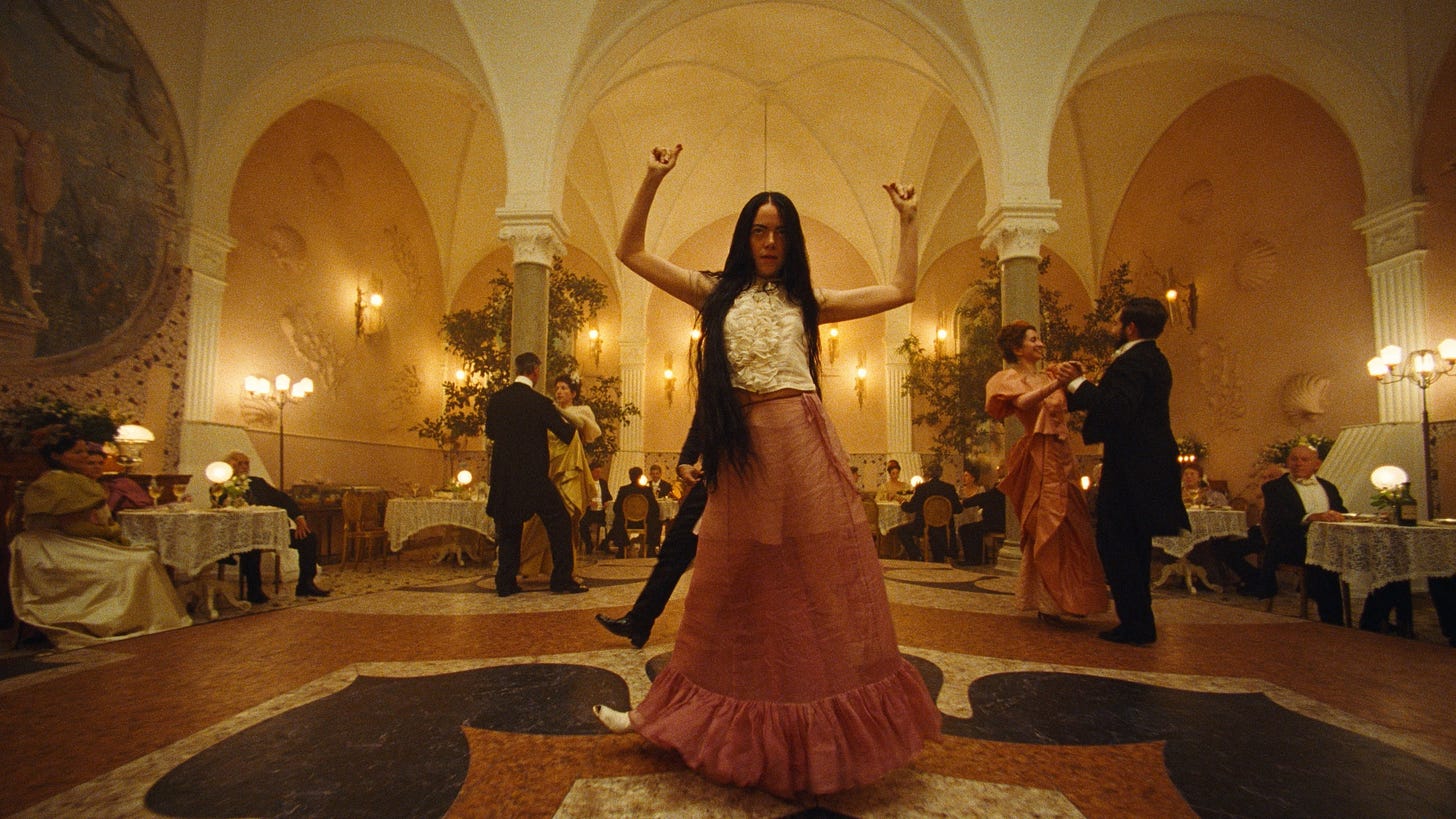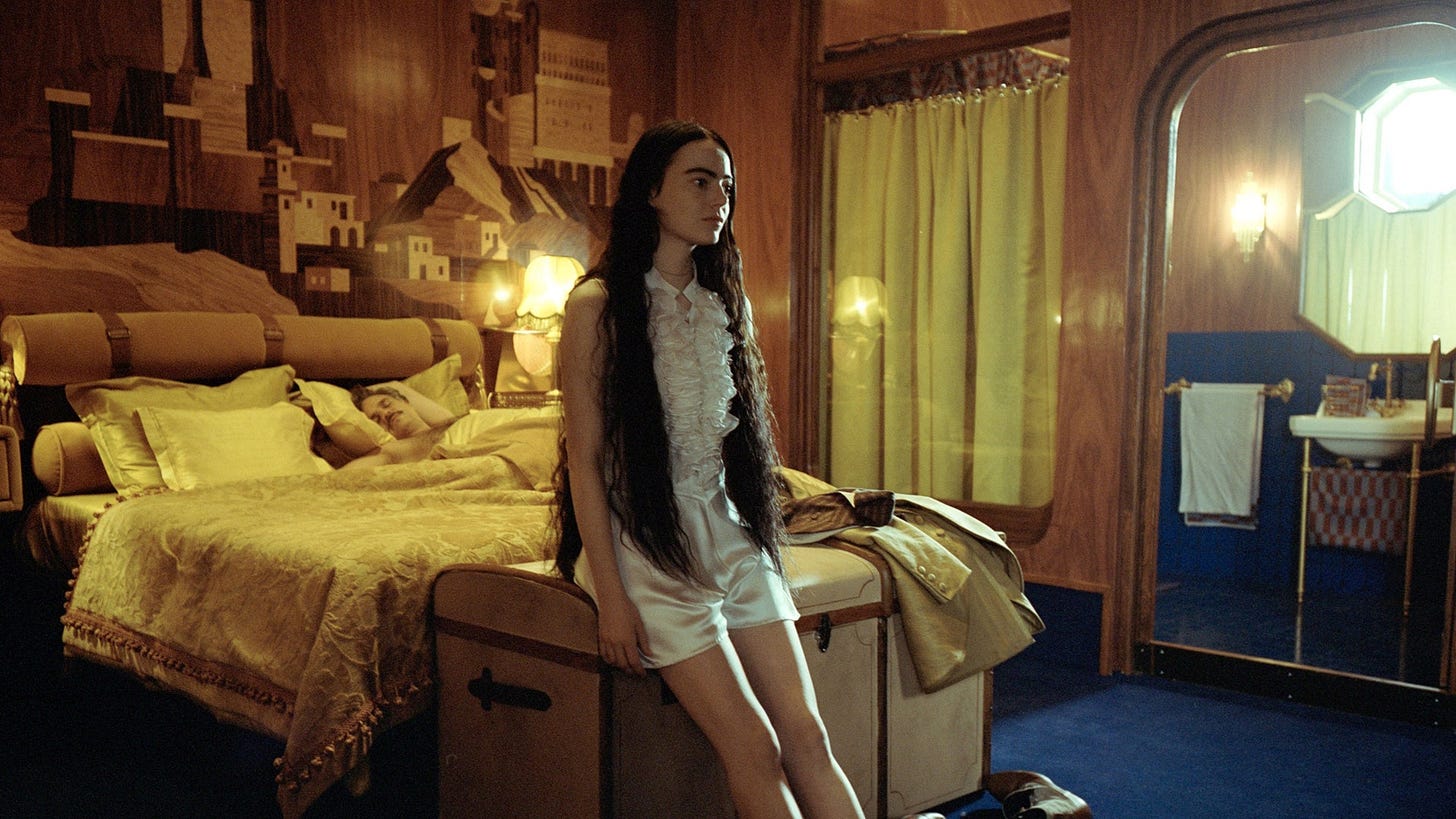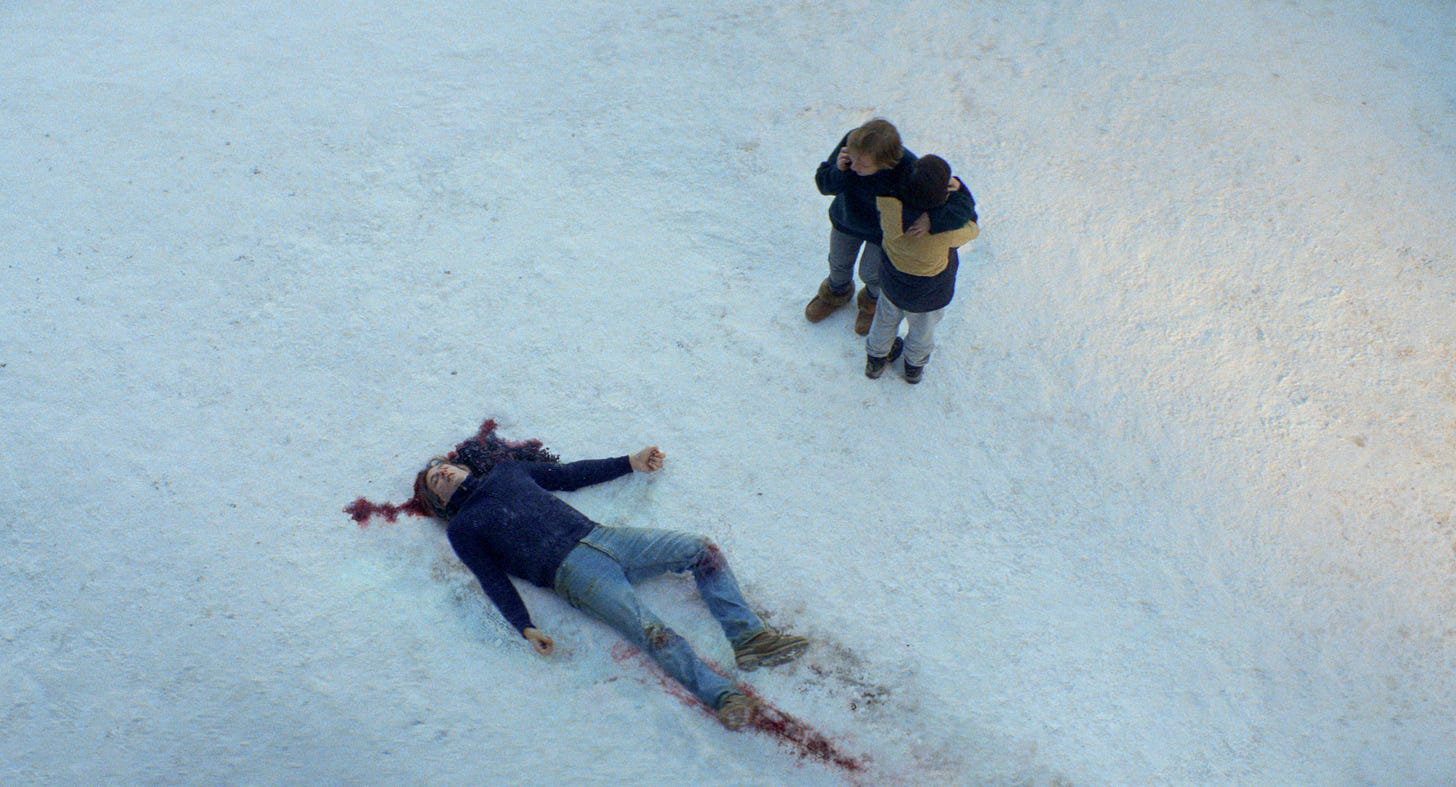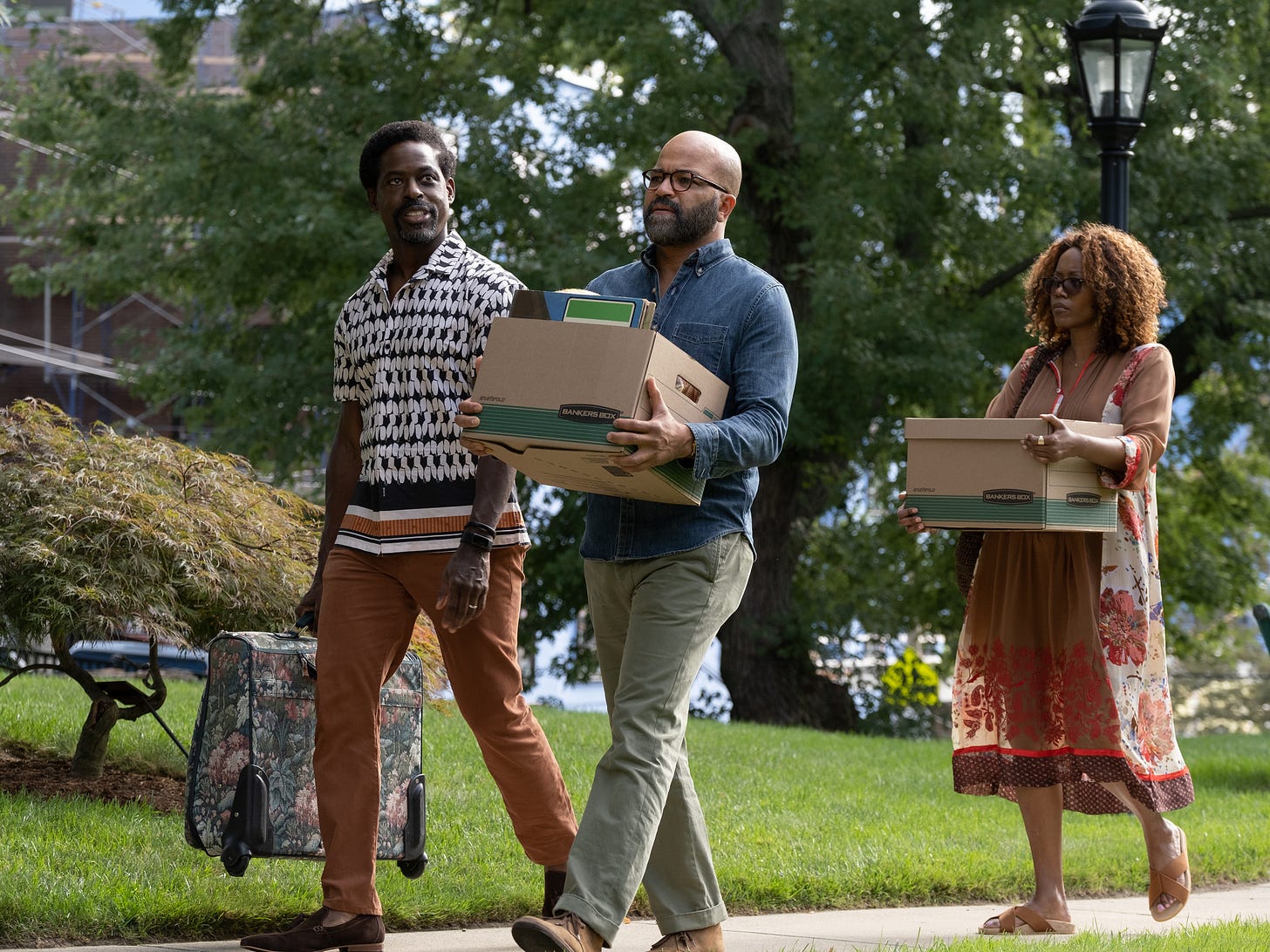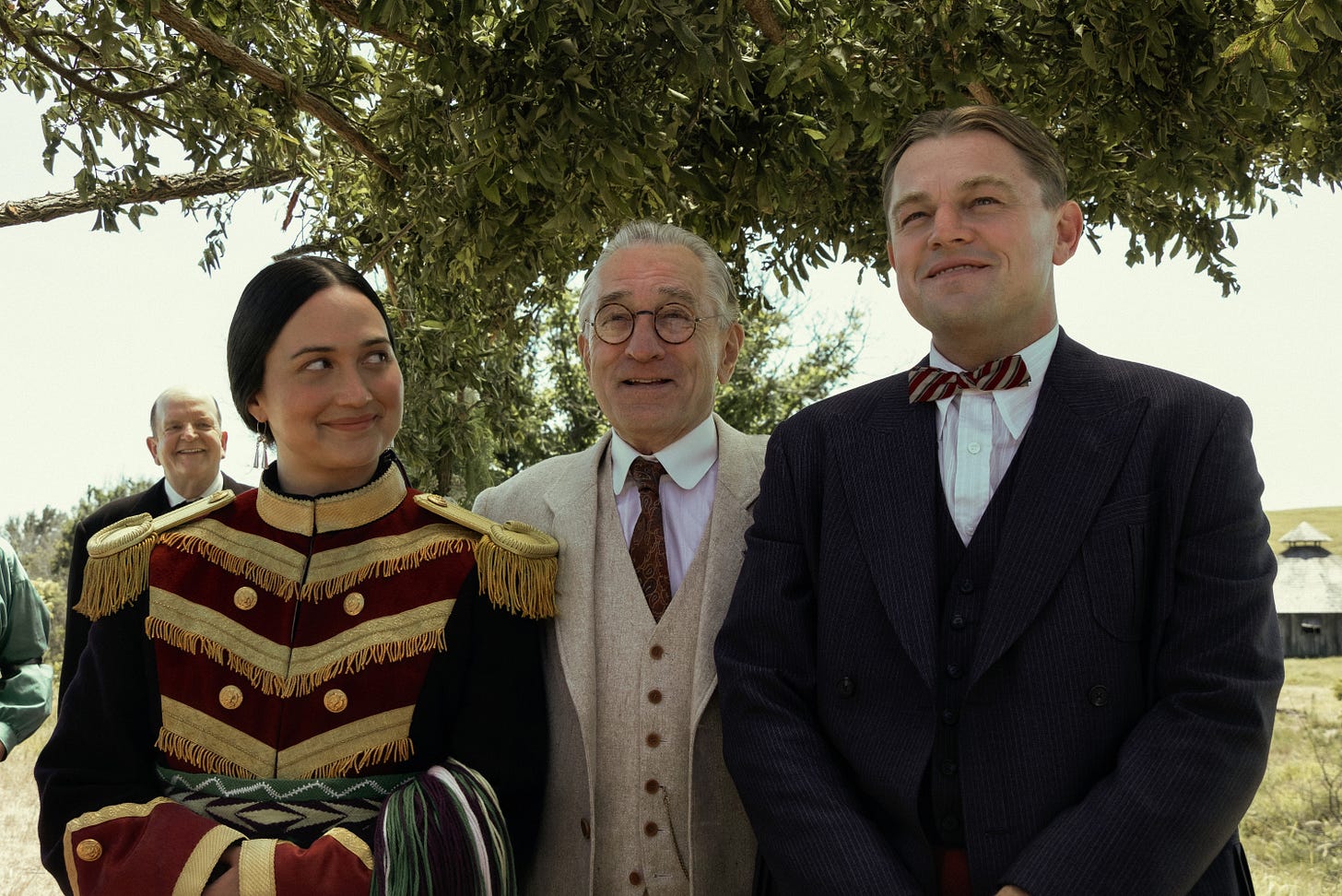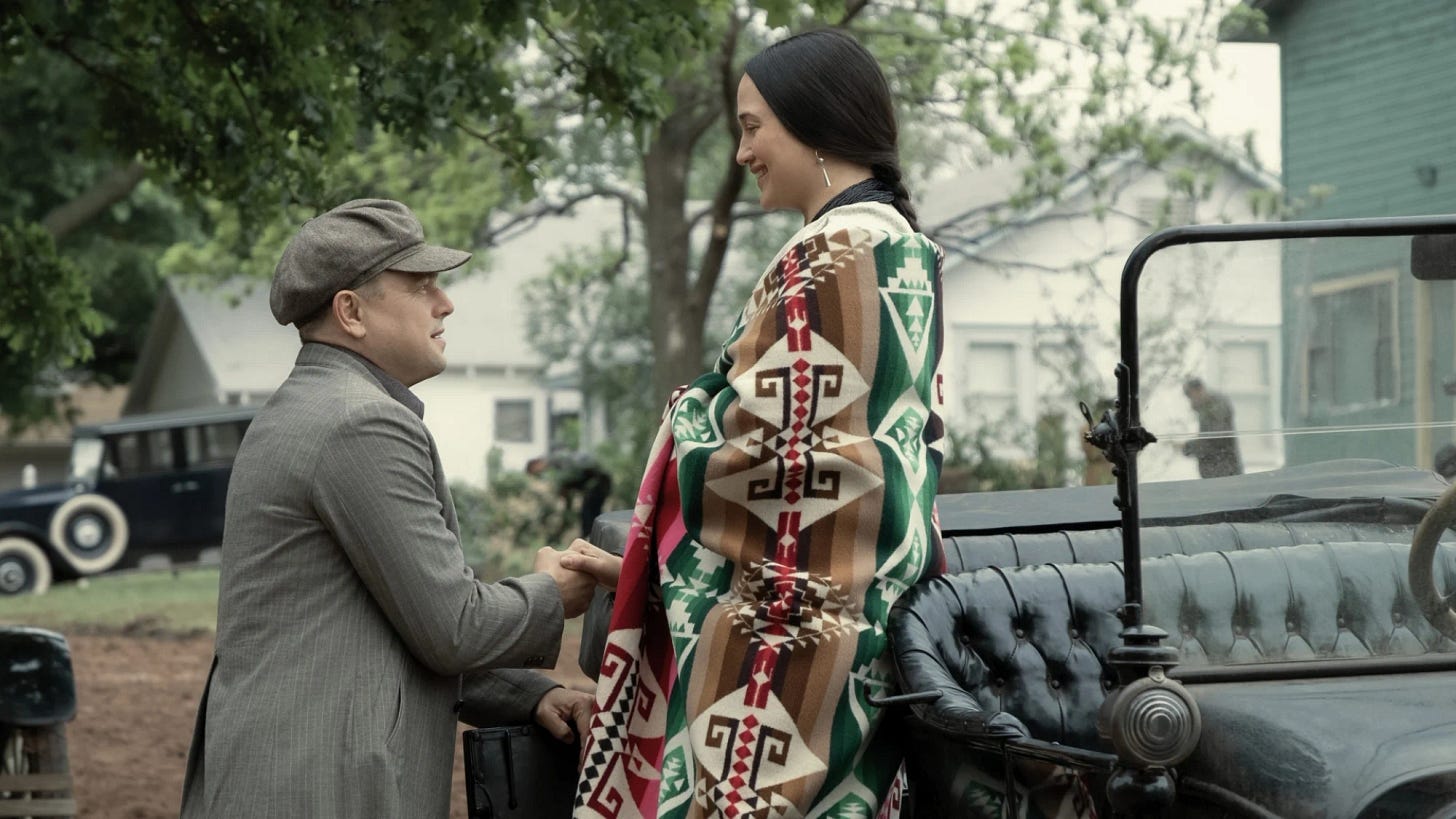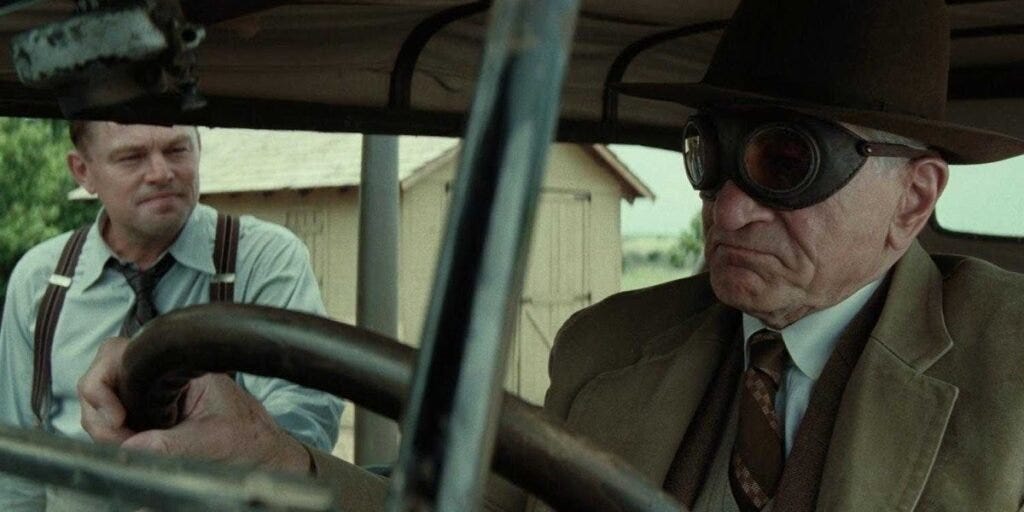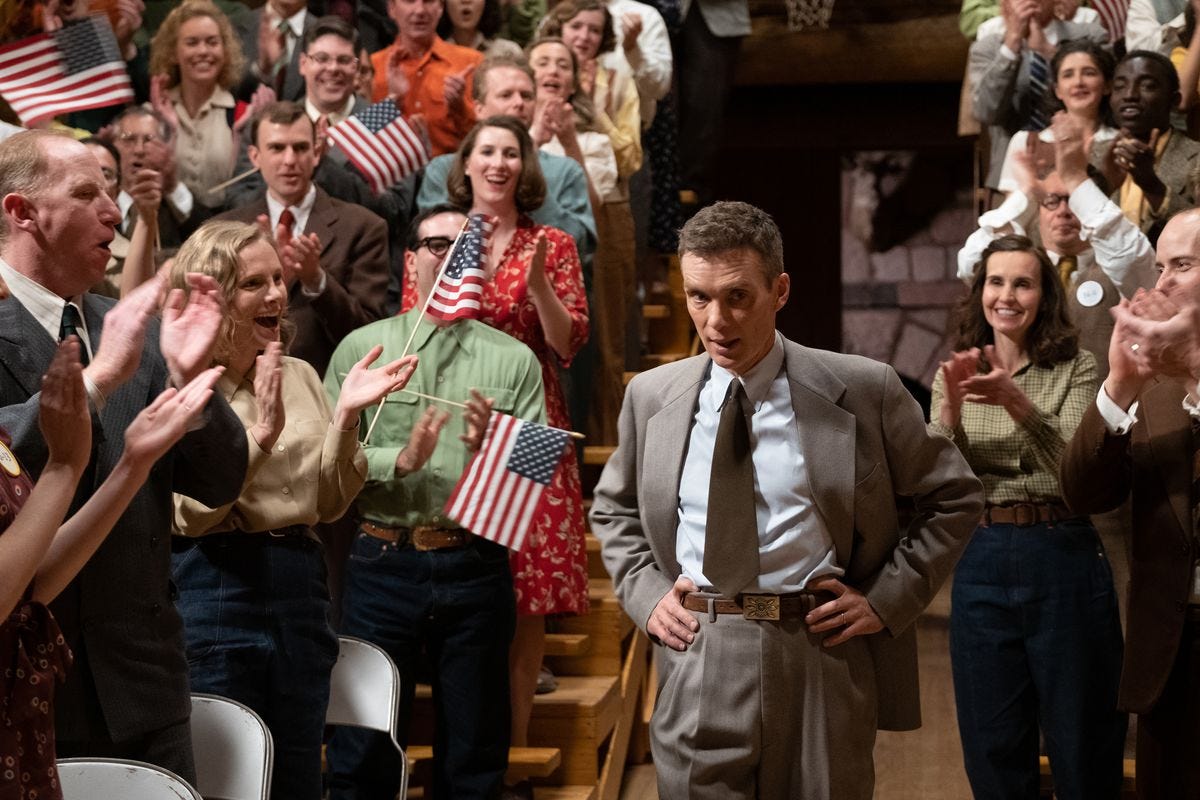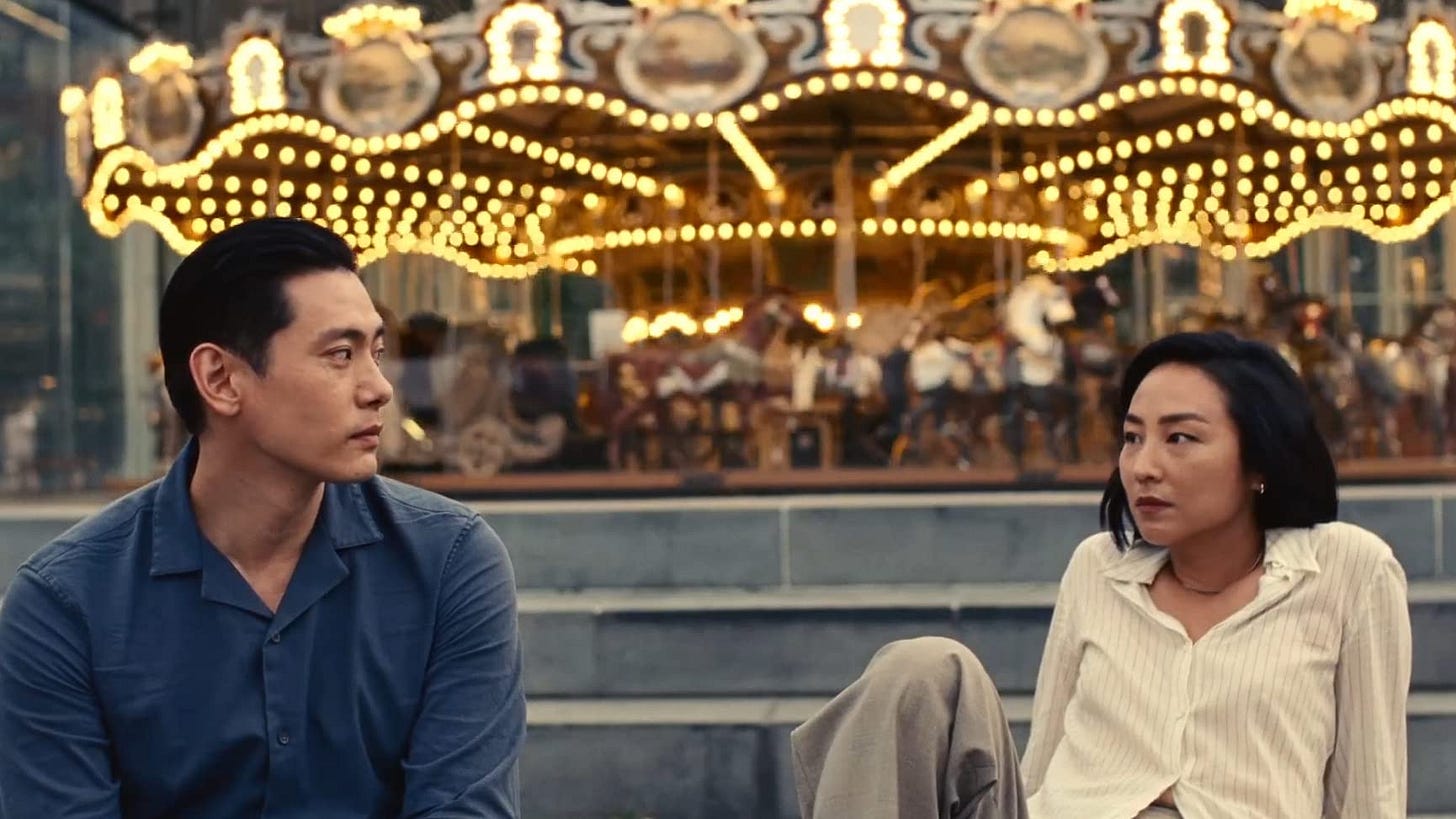Content Corner Oscars Guide: 2024 Best Picture Nominees
Watched all the Best Picture noms so you don't have to
Happy Oscar Sunday! I watched all the Best Picture nominations so you don’t have to. For thoughts on Barbie (2023) and Maestro (2023), head back to the July newsletter and November Movie Review.
I also saw The Pianist (2002) and Dressed to Kill (1980) in February, but we’ll talk about those films next week. In the meantime, let’s get into it:
Poor Things (2023, dir. Yorgos Lanthimos) — As a rando on Twitter — I mean, X — put it: “they hate see a bitch with childlike wonder.” SO true. A steampunk fever dream, Poor Things follows the adventures of female Frankenstein Bella Baxter (played by Emma Stone), the creation of British scientist Godwin Baxter (played by Willem Dafoe), from Lisbon to Alexandria to Paris. Throughout her travels — with ladies’ man lawyer Duncan Wedderburn (played delightfully by Mark Ruffalo), then alone —, Bella undergoes an unconventional coming-of-age journey.
While elements of its aesthetic, tone, and narrative might reflect other pieces of media (see: A Series of Unfortunate Events (2004), The Elephant Man (1980), Frankenstein (1931), etc.), Poor Things possesses a singularity that stems from how director Yorgos Lanthimos and screenwriter Tony McNamara combine those elements, how Stone embodies Bella. Extremes define the film. The degree of Bella’s initial innocence becomes the lens through which the audience experiences the threads that weave the tapestry of our society; in turn, elemental refractions of sex, of poverty, of philosophy, get held up for examination and, by extension, questioning.
Much has been made of the film’s frank depiction of sex, with critics decrying Bella’s journey as overly shaped by the male gaze of its director. Stone commented on this discourse in an interview with BBC Radio 4's Front Row, per Cosmopolitan, explaining: “So much of this was about being true to Bella's experience…[The sex] is obviously a huge part of her experience and her growth, as it is, I think, for most people in life. So for the camera to sort of shy away from that, or to say like, ‘Okay, well, we'll just cut all of this out because our society functions in a particular way,’ it felt like a lack of being honest about who Bella is.”
Where to Watch: Hulu (subscription), ~a theater near you~
Anatomy of a Fall (2023, dir. Justine Triet) — First things first, I need you to jam to Bacao Rhythm & Steel Band’s cover of 50 Cent’s PIMP for a minute to get the vibe going.
Okay, great.
Set near Grenoble, the French courtroom drama opens with novelist Sandra Voyter (played by Sandra Hüller) trying — and failing — to hold an interview with graduate student Zoé (played by Camille Rutherford) as her husband, writer and lecturer Samuel Maleski (played by Samuel Theis), blasts the aforementioned song in the attic of their chalet (now bookable on Airbnb, FYI). The couple’s eleven-year-old son, Daniel (played by Milo Machado-Graner), who suffers from visual impairment as a result of optic nerve damage, returns home from a snowy walk with their dog (played by Messi, arguably this year’s biggest Oscar snub) to find his father dead from a fall through the open attic window. As culpability gets called into question, the narrative transitions into Marriage Story (The French Legal System’s Version).
In a review for The New Yorker, Anthony Lane correctly categorizes every aspect of the film as “slippery to the touch,” a quality most strongly embodied by Sandra Hüller. He writes: “The miracle is that such uncertainty renders Hüller’s performance sharper rather than vaguer…When she stands outside on a frosty night, drinking and flirting with her lawyer, is she grabbing a rare chance to relax, or subtly swaying him yet further to her cause? How much we like or dislike Sandra is of no consequence. What’s unnerving is that we can’t decide, from one scene to the next, how secure we are in wanting to root for her.”
To me, Milo Machado-Graner forms Anatomy of a Fall’s emotional core as Danny. His teary testimony serves a reminder of the narrative’s stakes, sheds light on the shifting sands that form memory, amidst the free-for-all circus of the French court. But the brilliance of this film lies not only in its actors, but also in director Justine Triet’s style. Lane goes on: “Triet is a specialist in the slow leak…This is not a sleuthing movie; there are cops, but they mill around the fringes of the plot, and there’s no Poirot to slalom in from a nearby valley, brush the snow from his mustache, and address the case. Instead, we become the detectives — reading every rune, probing for holes, and testing the evidence as if we were treading on ice.”
Also, here’s a fancam of hot lawyer Vincent Renzi (played by Swann Arlaud). You’re welcome! xx
Where to Watch: ~a theater near you~, Amazon Prime Video ($5.99)
The Zone of Interest (2023, dir. Jonathan Glazer) — What haunting, atmospheric masterpiece of a film. A co-production between the UK and Poland, The Zone of Interest focuses on the family of Auschwitz commandant Rudolf Höss (played by Christian Friedel). While he selects the most efficient pesticides to massacre millions of Jews, Höss and his family live adjacent to the concentration camp in complete peace, in a villa his wife, Hedwig (played by Sandra Hüller), likens to paradise.
Early on in The Zone of Interest, Hedwig sits at her vanity. Laser-focused, she applies makeup while her youngest daughter, Annegret, cries in another room. This kind of extreme compartmentalization comes to define the moral texture and physical environment of the film. Gunshots, trains, and furnaces hiss over the garden wall, but the Höss family maintains its insulation. In a review for The Guardian, film critic Wendy Ide writes: “They [the Höss family] enjoy wholesome, halcyon picnics by the river (predominantly captured, like most of the picture, in dispassionate mid and wide shots) and idyllic days in the lush, lovingly tended garden of the Höss villa, a source of considerable pride for Hedwig. We never see beyond the walls that separate her cherished roses and dahlias from the industrial death factory on the other side. But through Johnnie Burn’s incredible, immersive sound design, the ambient noise generated by the horrors within the camp is evoked with a suffocating intensity that matches the choking pall of smoke billowing continuously from the Auschwitz furnace chimneys.”
The strongest crack emerges when Hedwig’s mother (played by Imogen Kogge) flees the house in the middle of the night, disturbed by the sight of fire from Auschwitz’s crematorium. Per Screen Rant, writer and director Jonathan Glazer has refuted any speculation around a guilt-ridden conscience propelling her departure, explaining: “It’s just the proximity. It’s no different, to someone like her, to buying your steak at Sainsbury’s and going to an abattoir. You know where that steak comes from, but you don’t really want to be around a cow being slaughtered or the smell of it, or have the blood running over your shoes . . . there’s no pang of conscience, no redemption. There’s no salvation in this film, and there can’t be. These characters end the way they start.” Glazer carefully constructs this sense of vacuous morality and emotional stagnancy, leveraging the film’s environmental qualities — its sound, its visuals — to underscore the extent of the family’s dissociation.
Where to Watch: ~a theater near you~, Amazon Prime Video ($19.99)
The Holdovers (2023, dir. Alexander Payne) — As a rando on Letterboxd put it: “babe wake up a new instant christmas classic just dropped” !! Wow, I loved this movie. Pisces-coded cinema at its finest (for other examples, see: Dead Poets Society (1989), Perks of Being a Wallflower (2012), Lost in Translation (2003), etc.).
What another Letterboxd rando describes as “The Shining if it was a heartwarming comedy,” The Holdovers centers on Stoner-coded classics professor Paul Hunham (played by Paul Giamatti) who teaches at New England boarding school Barton Academy in 1970. Firm in his principles and standards, Paul finds himself despised by students and staff, under fire for refusing to kowtow to high-profile donors. As winter break begins, he gets stuck supervising a group of students unable to return home for the holidays (aka: “holdovers”). Slowly, unlikely connections form between Paul, loner student Angus Tully (played by my new age inappropriate crush, Dominic Sessa), and the school’s head chef, Mary Lamb (played by Da'Vine Joy Randolph).
The 70s have a reputation for nihilism. As a result, happy endings make rare appearances in the cinema of the decade. I could reference any number of films to substantiate this point, but consider Days of Heaven (1978), which I discussed back in December. Occupying a kind of moral ambiguity, its characters hurdle toward their fates through the worst of actions and best of (for the most part) intentions. Meanwhile, Director Terrence Malick, shooting natural lighting at dusk, prioritizes an earthy palette in tune with the muted mood of the era. The Holdovers preserves these emotional and aesthetic textures.
In a blog post for The Script Lab, dramatist and journalist Martin Keady writes: “Alexander Payne’s The Holdovers (2023) is not just set in the 1970s (to be exact, the winter of 1970 and 1971) but is a 1970s-type film, one that delights in writing, directing, and acting that is as blurred, muted and mutable as life itself, like all the best movies of that fabled decade…According to a Letterboxd article, Payne said: ‘In a way, I’ve been making ’70s movies my whole career. I focus on what I hope are very human stories, as opposed to stories of device, convention, or contrivance. I like having a protagonist and story who approximate real life much more than movie life.’”
The late 1960s ushered in an obliteration of happy endings, as film (anti)heroes began to meet violent or quietly unsettling ends. Think of Bonnie and Clyde (1967), its titular characters riddled with bullets on the side of the road, or The Graduate (1967), that closing shot of Benjamin Braddock (played by Dustin Hoffman) and Elaine Robinson (played by Katharine Ross) numb on the back of the bus. The filmmakers of the ensuing decade continued to operate within this binary, teasing out its extremes. The Holdovers takes an approach more in line with The Graduate than Bonnie and Clyde through an ending that, without spoiling specifics, becomes predicated on the power of connection and sacrifice.
Where to Watch: Peacock (subscription), Amazon Prime Video ($5.99)
American Fiction (2023, dir. Cord Jefferson) — Where Anatomy of a Fall and The Holdovers adopt the texture of an archetypal literary fiction novel, American Fiction — ironically, perhaps intentionally — plays out like a commercial fiction book. (If you’re like “what’s the difference?,” think Taylor Jenkins Reid for commercial and Brandon Taylor for literary; someone like Sally Rooney, as I see it, straddles the line between the two classifications by developing literary novels with commercial appeal.)
The film follows Black writer and professor Thelonious "Monk" Ellison (played by Jeffrey Wright), a Capricorn-coded Gen Xer put on temporary leave for butting heads with his students. Returning to his hometown of Boston, Monk finds himself reunited with his family — and placed under significant pressure to cover the cost of care for his mother, Agnes (played by Leslie Uggams), a woman rapidly deteriorating at the hands of Alzheimer’s. In a burst of frustration, he drafts what he considers a joke of a novel, a parody of the stereotype-laden commercial fiction about “the Black experience” dominating bestseller lists. His agent, Arthur (played by John Ortiz) sends it out under an alias. To Monk’s surprise, the manuscript piques the interest of a notoriously particular editor (played by Miriam Shor), launching his ascension into anonymous fame.
That summary outlines only the top layer of the plot, a narrative intricately laden with character after character, melodrama after melodrama. In fiction, revealing dialogue can serve as a clever means of showing rather than telling; one character might comment on a particular characteristic, reference a past event, teasing out context for the reader through the course of conversation. This approach works in literary fiction because it provides a subtler alternative to narrated exposition. Film, as I see it, has different rules. The “show, don’t tell” approach becomes environmental rather than verbal; for instance, think of Sofia Coppola’s shots of Cailee Spaeny at Graceland in Priscilla (2023), how the property’s sprawling emptiness conveys its ability to elicit isolation.
American Fiction packs its dialogue with psychological exposition, beats its characters’ experiences and defining qualities to death. To give an example, Monk’s siblings constantly reference how he was his father’s favorite, how they’re ~sooo similar~ in their inability to ~trust~. These heavy-handed conversations, from my perspective, simultaneously muddle and spoonfeed the narrative. But as Adam Brody’s hard-hitting Hollywood director puts it in the film: “Nuance doesn’t put asses in theater seats.” That refrain begs the question of to what extent American Fiction’s overwrought plot, simplistic dialogue, and unmemorable aesthetic operate as intentional choices designed to mirror Monk’s practical joke, writer and director Cord Jefferson’s own attempt to dress up his frustrations as a marketable film in service of its saving grace (aside from Jeffrey Wright’s performance): its message.
The film underscores the societal notion of “the Black experience” as faulty, a multiplicity too often presented as singular, exposing how white voices propel this idea through misguided attempts to soothe their own consciences. In a review for RogerEbert.com, freelance film writer Peyton Robinson notes: “American Fiction trips over its own feet in its final act, stumbling between daydream sequences and multiple storylines before finding a final, underwhelming resolution. But the attentive lens that the film devotes to its concept and themes is what will be remembered. Jefferson’s film succeeds best when it’s being thoughtful, even as it often tries too hard to implore you to react. It carries a sensitive, important declaration in its bones: A testament to the versatility and validity of where Black art meets Black life, and a sharply pointed finger at the many institutional factors that keep it, and its creators, restrained.”
A final aside: You know I have to comment on Monk’s literary nemesis, Sintara Golden (played by Issa Rae) conflating Bret Easton Ellis and Charles Bukowski, flippantly characterizing both authors as writing “about the downtrodden.” In a Substack titled “The Problem with American Fiction,” author Ross Barkan writes: “What’s strange to me still is that so few critics commented on the factual inaccuracy of Sintara’s response. If I am being generous, I might argue Jefferson does it purposefully to undermine a character he likes less, but that doesn’t seem to be the case. He sketched her with compassion and took this exchange seriously. Sintara — or Jefferson — manages to conflate Charles Bukowski and Bret Easton Ellis, two writers who share a race, a gender, and a hometown (Los Angeles) and almost nothing else…her description of Ellis is nonsensical. American Psycho, Ellis’s magnum opus, is told from the vantage point of an increasingly unhinged Wall Street investment banker, and his other novels are studies, in one form or another, of the corrosive effects of wealth and privilege. His latest novel, The Shards, is one of his best, and is set, like Less Than Zero, in the most exclusive neighborhoods of Los Angeles, shuttling among beach clubs, night clubs, and private school campuses. Ellis, quite literally, does not write about the downtrodden.”
Where to Watch: ~a theater near you~, Amazon Prime Video (premium subscription)
Killers of the Flower Moon (2023, dir. Martin Scorsese) — In the March newsletter, I discussed the talk author Brandon Taylor gave at Columbia last month on moral worldbuilding, now published on his Substack. Discussing the state of the contemporary novel, Taylor calls for “fiction set in a world that has values and patterns of emphasis and de-emphasis,” created through a combination of characters with values and a reintroduction of honest-to-God villains. To me, Killers of the Flower Moon serves as an unintentional cinematic answer to Taylor’s call for a more textured moral relief in fiction.
Set in 1920s Oklahoma and based on the 2017 nonfiction book by journalist David Grann, the western crime epic recounts the Osage Indian murders, a killing spree that occurred over the course of a decade after the discovery of oil on tribal land. Per Business Insider: “Pushed west by the United States in the 1800s, the Osage people purchased land from the Cherokee Nation in 1872, settling in Northeast Oklahoma. When oil was discovered on the land in 1894, the tribe was among the wealthiest people in the world, attracting opportunistic outsiders who sought their fortune by dubious means.” Law required that white, court-appointed legal guardians manage Osage money, spurring a string of interracial marriages driven by dubious intent.
The narrative zeroes in on World War I veteran Ernest Burkhart (played by Leonardo DiCaprio), who returns home to live with his brother, Byron (played by Scott Shepherd) and uncle, William King Hale (played by Robert De Niro). Despite presenting as a friend to the Osage, Hale puppeteers armed robberies and contract killings to amass wealth. When Ernest marries Osage woman Mollie Kyle (played by Lily Gladstone), Hale concocts an inheritance scheme that puts her life, as well as those of her mother (played by Tantoo Cardinal) and sisters (played by Cara Jade Myers, JaNae Collins, and Jillian Dion), in danger.
Lily Gladstone, my personal pick for the Best Actress Oscar, gives a stunning, layered performance as Mollie. As Mashable Film Editor Kristy Puchko writes: “Opposite DiCaprio and De Niro, Gladstone is a rock, standing firm and not to be outshone by these A-listers. Her performance is one of keening and personal agony, but also of joy and steely resilience. While Ernest may be a fool, Mollie isn't. Her slight smirk and playful side-eye show that she understands a lot about his motives from the jump. But how could anyone predict how deep a betrayal this suitor with the foolhardy grin could muster?” She captures the full spectrum of human emotion, from breaking down at the news of death after death to creating a PG-rated daytime edition of DiCaprio’s infamous Titanic (1997) car scene. Her resolve, the vulnerability that creeps behind it, reaches a fever pitch in the film’s penultimate scene, a subdued stand-off between husband and wife.
In “living shadows: aesthetics of moral worldbuilding,” Brandon Taylor writes: “I think it is important to return to an attitude of [moral] hierarchy with respect to our minor characters…let them act and operate in a way that is outside the capacity for judgement of your protagonist. To truly reintroduce an element of the unknown and unknowable into the populace of your story world. To ask if it is possible that somewhere out there, lurking in all the shadows of the land, there is a person capable of tremendous evil without explanation. The very potential for the existence of such a being will improve almost any story. Because it means that there are real consequences and real stakes.” In Killers of the Flower Moon, De Niro’s Hale emerges as the embodiment of evil, a crime boss driven by greed without any kind of conscience. The singularity of Hale’s moral texture prevents the emergence of what Taylor calls a “flattened narrative relief,” sharpening Ernest’s complexity — and the narrative’s stakes.
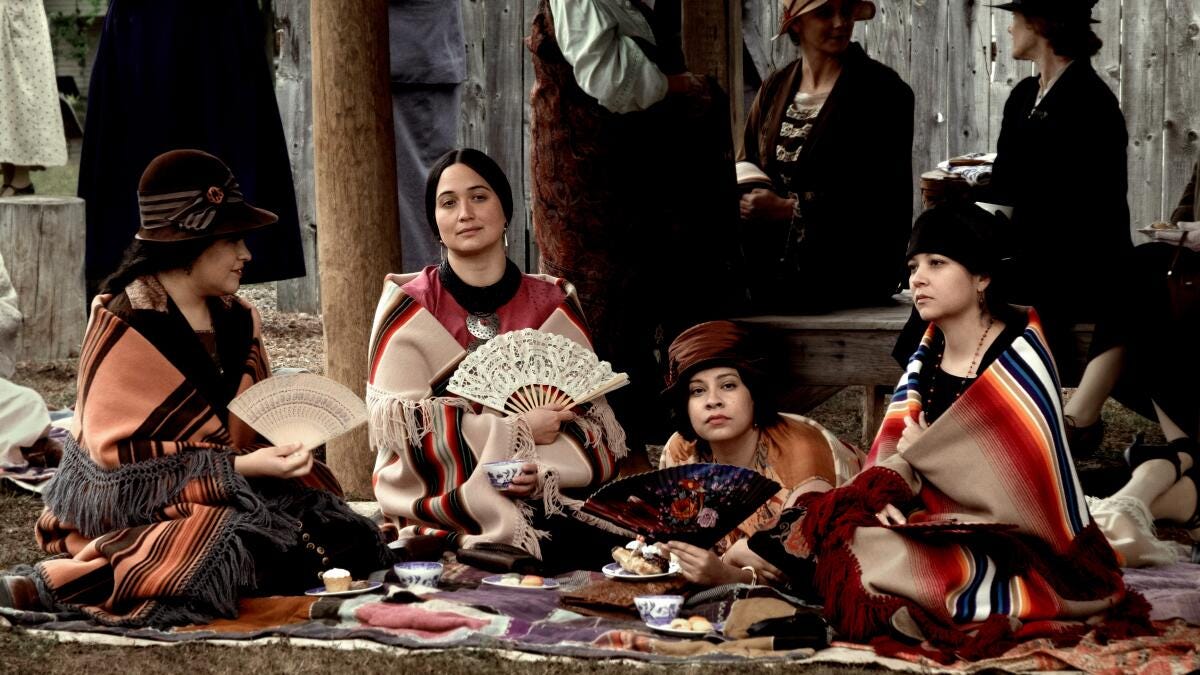
Moreover, Taylor urges fiction writers to “ask better, deeper questions about the moral logic of the world you create and its value systems.” He goes on: “Do not merely copy and paste the value systems of our world into your story. Ask yourself, is this particular milieu I am describing governed by the hazy rules I feel in my own life or by some set of more concrete if arbitrary norms. Think vividly and deeply about the governing logic of the values you give your characters. Indeed, give your characters values.” From his integration of black-and-white photographs and of-the-era newsreels to the late Robbie Robertson’s score, Scorsese creates an immersive cinematic experience rooted in the financial, emotional, and political stakes of another time, respectfully distilling the values of real people, of a distinctive culture, into his recreation.
Osage Slate contributor Joel Robinson writes: “Before I saw Killers of the Flower Moon, I spoke with Jim Gray, a former chief of the Osage Nation. In our conversation, he told me that he’s never seen a film immerse itself in a culture like this one did with ours. Having now seen it, I have to wholeheartedly agree. Language was taught by our teachers, including Christopher Cote, who gave a wonderful interview after he saw the film at the Los Angeles premiere. The costumes were made by Osage artists. Everything feels authentic to the time period…viewing the plot through the lens of Ernest grants the non-Osage audience the opportunity to gain more knowledge and understanding of the murderous scheme as the movie goes on…I think it would take an Osage to make this film from the perspective of an Osage person. The problem is that, as Gladstone has said, no one is giving an Osage filmmaker Scorsese money to tell our story right now.”
Where to Watch: Apple TV+ (subscription), Amazon Prime Video ($19.99)
Oppenheimer (2023, dir. Christopher Nolan) — Christopher Nolan’s epic biopic traces the life of the atomic bomb inventor, “American Prometheus” J. Robert Oppenheimer (played by Cillian Murphy), across a nonlinear narrative. One timeline, “Fission,” shown in color, traces Oppenheimer’s life from his own perspective, from his time at Cambridge to the aftermath of dual bombs dropping on Japan to his 1954 security clearance hearing. Meanwhile, the black-and-white timeline, “Fusion” follows the 1959 Senate confirmation hearing for United States Atomic Energy Commission chair Lewis Strauss (played by Robert Downey Jr.).
In a piece for The New Yorker, Richard Brody writes: “The movie is structured as a sort of mosaic. Deftly edited by Jennifer Lame, it intercuts the various periods of Oppenheimer’s life — rise, struggle, fall, aftermath — continually connecting the early leftism and later pacifism with the tribulations during the McCarthy era.” From my perspective, the film could have benefitted from a bit more clarity, especially in its opening half hour; I personally found the timeline difficult to follow, the characters challenging to identify without a Wikipedia crutch. I also would argue for a more streamlined narrative. In trying to trace the full scope of Oppenheimer’s life, Nolan, from my perspective, ends up with, in some ways, cursory capture.
Brody goes on: “What’s missing, above all, from Nolan’s connect-the-dots version of Oppenheimer’s life is the kind of utterly outlandish detail in which that life abounded. For instance, Nolan shows Oppenheimer, as a student at Cambridge, injecting potassium cyanide into an apple belonging to a professor who humiliates and punishes him for poor laboratory technique — apparently to no consequence. Later, Oppenheimer lets on, in a quick aside, that he was forced into psychoanalysis as a result. In fact, he was threatened with criminal charges and with expulsion, and only the pleas of his father, a prosperous businessman, spared him. In the movie, this reckless, potentially deadly whim comes out of nowhere, but there are plenty of other episodes in Oppenheimer’s life to suggest that a truly violent personality.”
Despite the potential for deeper psychoanalytic insight, Murphy and Nolan offer empathetic flashes into Oppenheimer’s inner life. The power of their collaboration, as I see it, renders the film a success. In one scene subsequent to the bombings, Oppenheimer rises before an applauding crowd, prepared to play the role of American hero. As he begins his speech, the room starts to shake. Skin peels off faces. Oppenheimer’s pulse races. The hallucination swallows his inner self, but his external message remains firm. Murphy’s wide-eyed depiction of Oppenheimer’s anxiety juxtaposes against his even tone, couples with Nolan’s heightened effects to distill the breach between the father of the atomic bomb’s private and public selves.
Where to Watch: Peacock (subscription), Amazon Prime Video ($5.99)
Past Lives (2023, dir. Celine Song) — Past Lives opens with a shot of three people at a bar. A voiceover, seemingly a couple on a date across the room, discusses the trio’s relationship to one other, tries to pin down the specific quality of their dynamic. This moment distills the tone of the film, a poetic meditation on the nebulous nature of connection, and initiates its elliptical narrative. After that first scene, the story flashes back to trace the lives of childhood sweethearts Na Young aka. Nora (played by Greta Lee) and Hae Sung (played by Teo Yoo) over the course of twenty-four years.
To me, multiplicity of identity drives the narrative tension in Past Lives. In one memorable scene, Nora gets ready for bed after meeting up with Hae Sung in New York. She unpacks the hangout with her husband, Arthur (played by John Magaro), ruminating on the cultural breach that time and circumstances have wedged between her and Hae Sung. Having immigrated from Seoul to Toronto to New York, experiencing a Westernized upbringing as a result, Nora says: “I feel so not Korean with him, but also more Korean?” Later that night, Arthur comments on how she dreams in Korean, a language he has yet to fully grasp. Part of Nora remains unknowable to both men, a fact that elicits resignation in Arthur and Hae Sung alike.
Writer and director Celine Song acknowledges and ultimately subverts the tropes often associated with this kind of love triangle (read as: justice for James Marsden in The Notebook (2004) !!). In bed one night, Arthur, a writer, doubts the power of his and Nora’s marriage, notes how it pales in comparison to the “story” of her friendship with Hae Sung (“I just keep thinking what a good story this is, and I can’t compete…in the story, I would be the evil white American husband standing in the way of destiny.”). Song plays with the distinction between the romanticized ideal of fated childhood sweethearts and the regenerative reality of love. Per Vulture, she explains: “‘It would be so much easier if Arthur was a jerk. Or if Hae Sung was possessive and came to New York to ruin Nora’s life. Or if you felt Nora wasn’t loved and she behaved immaturely.’ In a medium where ‘drama comes from adults behaving like children…How can we find drama in three people trying to do their best to not hurt each other, even though the situation is impossible?’”
The narrative cycles through twenty four years before returning to the bar from the opening shot. Nora, Hae Sung, and Arthur sit on stools, partaking in a collective conversation with Nora as translator. As the night goes on, an intimacy emerges between Nora and Hae Sung. They break off into their own world, a discussion entirely in Korean riddled with reflections and confessions (“I didn’t know liking your husband would hurt this much.”), while Arthur sits beside them in silence. Without spoiling specifics, Past Lives culminates in a heartbreaking conclusion that, per Song, reflects “how love manifests itself not as a neat path and isn’t about choosing right or wrong — it’s a separate entity that exists in its own life.”
Where to Watch: Hulu (premium subscription), Amazon Prime Video (premium subscription)
Alright, that’s it for now!
xo,
Najet





